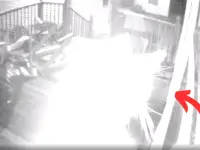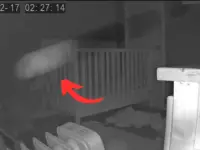2. The Tunguska Event

On June 30th, 1908 at around 7:17am, Russian settlers living and working in the hills north-west of Lake Baikal witnessed the strange sight of a brilliant bluish light streaking across the sky. Approximately ten minutes later, there was a loud explosive sound that seemed to move from the east to the north, with a massive shock wave accompanying the sound that shattered windows and knocked people to the ground hundreds of kilometers away. The blast and shockwave also flattened around 80 million trees, destroying 2,000 square kilometers of the local forest.
No one really knows precisely what happened that morning in 1908. Some scientists think that the explosion was caused by a meteor strike. It was thought to be 1,000 times greater than the atomic bomb that was dropped on Hiroshima, yet there is no crater in the vicinity that the explosion occurred. It’s interesting to note that the explosion left the skies lit up for several days after the event occurred and this light was visible across Asia and Europe.
While the Tunguska Event is technically listed as an impact event, there is no proof that a meteor ever fell on that day. One theory suggested that the event was caused by a comet rather than a meteor. Comets are composed of ice, unlike meteors, which are composed of rock. If the object that streaked across the sky was a comet, it would have likely disintegrated when it reached Earth’s atmosphere. Still other natural theories involve air bursts from comets or asteroids, or the ignition of a natural gas pocket in the Earth’s crust. Other more unusual theories include alien experimentation and even miniature black holes. No definitive proof has ever been produced for any of the theories mentioned. Scientists and researchers continue to investigate this strange event even today.
1. The Lost Colony of Roanoke

In 1587, a small group of English settlers were taken to Roanoke Island, a barrier island that is part of the Outer Banks of North Carolina. The settlers found life in their new home to be particularly hard. Food was scarce and some of the local natives were openly hostile. The settlers themselves were not particularly suited to the new life they had chosen, and fatigue as well as disease began to take a toll almost immediately. White, who had been named the mayor of Roanoke, opted to leave the settlement to return to England to request additional settlers who had the practical experience needed to make the colony a success as well as additional resources and supplies. White left his wife, child, and grandchild behind at Roanoke. It took him three years to make his way back to the colony, due to inclement weather as well as the Anglo-Spanish War.
When White finally made his way back to Roanoke, the settlement was deserted. White had left behind 90 men, 17 women, and 11 children, but there was no sign of anyone in the vicinity. There was also no sign of a struggle or an attack, and the only clue left was the word Croatoan carved into a nearby tree. White and his crew couldn’t continue to search due to an impending storm, and they had to return to England without any idea of what had happened to the lost colonists.
Sir Walter Raleigh set out in 1602 to attempt to find out what happened to the colonists, but once again the weather interfered and Raleigh and his crew never even landed on the island. A final attempt was made in 1603 by Bartholomew Gilbert, but bad weather forced them to land in an unidentified area. The landing party as well as Gilbert was killed by Native Americans on July 29th.
Claims have been made that the colonists were killed by the Powhatan tribe, but no evidence has ever been found to support this. Another popular theory is that the colonist integrated with the Croatoans as well as other native tribes, and that perhaps the enigmatic message Croatoan was an attempt to notify John White that they had gone to the tribe for help. Unfortunately, no DNA evidence had ever been produced that would support this theory and the fate of the Roanoke colonists still remains a mystery.
—
So there’s our list of 5 historical events no one can explain. Do any of these mysterious events have a plausible explanation? Let us know in the comments section below or on any of our socials.







